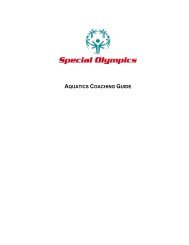Bocce Coaching Guide - Special Olympics
Bocce Coaching Guide - Special Olympics
Bocce Coaching Guide - Special Olympics
You also want an ePaper? Increase the reach of your titles
YUMPU automatically turns print PDFs into web optimized ePapers that Google loves.
Understanding the Game<br />
32<br />
<strong>Bocce</strong> <strong>Coaching</strong> <strong>Guide</strong><br />
Teaching <strong>Bocce</strong> Skills<br />
Do not assume that lower ability players will know even the basic aim of the game. Such players may have difficulty<br />
with simple concepts such as distinguishing between teammates and opponents.<br />
Basics and Aim of the Game of <strong>Bocce</strong><br />
<strong>Bocce</strong> is played with a set of eight large balls and one small target ball called a pallina (Italian for little ball). The<br />
pallina is sometimes also called a jack, kitty, cue ball or pill. The larger balls are roughly 107mm in diameter and weigh<br />
approximately 900 grams. Each of the opposing team s balls are of two distinct different colors, and sometimes<br />
markings. The different markings assist people who may have a visual impairment and require touch to differentiate<br />
balls.<br />
Events are usually singles, doubles or teams (any more on a court can lead to overcrowding). A game is begun by<br />
the toss of a coin to establish who goes first. Once the initial toss has been made, the pallina and the first ball of that<br />
team is rolled. The opposition will then roll their first ball down the court and hope that they get closer to the pallina.<br />
If the opposition is successful in their attempt, the first team will try and better it again. If they are not successful,<br />
they will continue to try until they achieve their goal or have rolled all their balls. Each team gets to roll or toss their<br />
four larger <strong>Bocce</strong> balls towards the pallina.<br />
The object of the game is to get as many of your balls as close to the target ball as your opponent. After both teams<br />
have thrown all their balls, the frame has ended and the distances between the Pallina and the <strong>Bocce</strong> balls are<br />
considered and points awarded. Only one team can score in each frame or end. Scoring is one point for each ball that is<br />
closer to the pallina than the opponents balls. In this way you can score up to four points in each frame or end.<br />
Competition games are usually scored up to 12 or 16 points per game; however, scoring in recreational games is<br />
limited only by the time players have to spare. It can be from three or four ends to nearly 30, depending on the number<br />
of points awarded following completion of each end. Depending on the skill of the players, a game can last anywhere<br />
from 15 minutes to an hour.<br />
Physical and Social Benefits of <strong>Bocce</strong><br />
Even when played on official courts, bocce is not a physically demanding sport. There is no pounding on the spine and<br />
knees as in basketball, no sprinting and sliding as in athletics or softball.<br />
You don t have to be in shape to play bocce, though physical fitness controls the fatigue factor in any competitive<br />
sport. On the other hand, the mental and social benefits of bocce are incalculable. Competing in any sport fosters a<br />
healthy outlook on life. And after all things are considered, bocce meets today s health and fitness standard of favoring<br />
lifetime sports over those that you can enjoy only in your youth.<br />
There are also the social mainstreaming benefits that occur when the playing field is level, in that this game does<br />
not require a vast amount of intellectual acumen for a player to be at the top level of the sport. Therefore a person with a<br />
disability can compete on an even basis against a competitor who has no impairment.<br />
<strong>Special</strong> <strong>Olympics</strong> <strong>Bocce</strong> <strong>Coaching</strong> <strong>Guide</strong>- December 2005

















